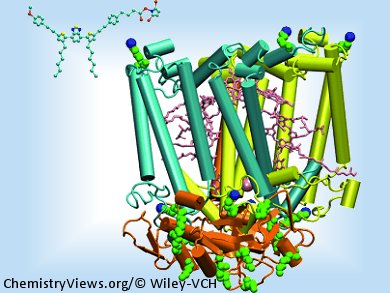Reproducing Photosynthetic Apparatus
Getting energy from sunlight: Plants have it down; humans have not quite got the knack for it. Hybrid systems made from natural and synthetic components could open new routes for harvesting solar energy. Italian researchers have now introduced an approach to this type of system. As described in the journal Angewandte Chemie, they have combined the photochemical core of a bacterial photosynthetic system with an organic dye that acts as an “antenna”, significantly improving the capture of light.
In all organisms fuelled by photosynthesis, the functional organization of the photosynthetic apparatus is the same: pigment-protein complexes capture the light like a radio antenna catching radio waves and conduct it to a central photochemical core, the reaction center. Here the energy is converted to an electron-hole pair: a negatively charged electron is separated from its molecular core, leaving behind a positively charged “hole”. This charge-separated state must be maintained long enough to be used. The organism uses this to drive its metabolism. In technological applications, charge separation may be used to drive a redox reaction like the splitting of water into hydrogen and oxygen.
Adding a Synthetic Antenna
Nature has optimal control over these steps. Synthetic systems that efficiently capture light and use the energy to achieve charge separation have also been developed; however the lifetime of the charge separation is barely in the millisecond range. This is not enough to allow the energy to be drawn off efficiently. An interesting approach to solving this problem is to make hybrid systems that combine a tailored synthetic antenna with a natural “light converter”. Previously, synthetic antennas have been made from quantum dots, nanoscopic structures made of semiconductors.
Instead, researchers led by Gianluca M. Farinola and Massimo Trotta have elected to use a tailored organic dye molecule as their antenna. These have several advantages over inorganic structures: The molecular diversity of organic compounds allows for very fine tuning of the spectroscopic and electronic properties of the antenna. At the same time, the molecular form and flexibility can be controlled so that the antenna has practically no effect on the reaction center and its function, unlike quantum dots. An organic antenna can also be attached to nearly any desired location on the reaction center.
The Italian researchers combined their organic antenna with the extensively researched reaction center of the purple bacterium Rhodobacter sphaeroides R-26. They demonstrated that the antenna does not disrupt the function of the natural light converted; instead it improves its activity in a range of wavelengths not efficiently absorbed by the purely biological system.
- Enhancing the Light Harvesting Capability of a Photosynthetic Reaction Center by a Tailored Molecular Fluorophore,
Francesco Milano, Rocco Roberto Tangorra, Omar Hassan Omar, Roberta Ragni, Alessandra Operamolla, Angela Agostiano, Gianluca M. Farinola, Massimo Trotta,
Angew. Chem. Int. Ed. 2012, 51(44), 11019–11023.
DOI: 10.1002/anie.201203404




